Abstract
Over the past few decades, Vietnam has been one of the fastest growing economies in Asia, experiencing a GDP growth rate of more than 6% per year. The energy industry plays an important role in Vietnam’s continuous development, so access to reliable and low-cost energy sources will be an important factor for sustainable economic growth. Achieving the goal of reducing global greenhouse gas emissions, as set out in the Paris agreement on climate change, will depend heavily on the development roadmap of emerging economies, such as Vietnam. Currently, developing hydroelectric plants is Vietnam’s optimal choice in order to meet its target of renewable energy development. Hydroelectricity in Vietnam is favorable thanks to the high average annual rainfall, about 1800–2000 mm, and the dense river system, with more than 3450 systems. In addition to providing electricity, hydropower plants are also responsible for cutting and fighting floods for downstream areas in the rainy season, at the same time providing water for production and people’s daily needs in the dry season. This work proposes the application of a multicriteria decision-making (MCDM) model to select the best option for the installation of river hydroelectric plants in Vietnam. The use of MCDM techniques in environmental decision-making, including selecting between various alternatives, is important when this involves complex decisions in several disciplinary fields. The most widely used of these techniques are the fuzzy analytical network process (FANP) and the technique for order of preference by similarity to ideal solution (TOPSIS). As a result, Nghe An (LOC05) is found to be the optimal solution for selecting river portions where hydroelectric plants are viable in Vietnam.
Keywords:
optimization techniques; hydroelectric; renewable energy; MCDM; fuzzy theory; FANP; TOPSIS 1. Introduction
Since the start of the 21st century, the global economy’s constant expansion has driven world energy demand to record levels. While thermal energy from fossil fuels provides the world with most of its need—nearly 79.68% [1]—the lack of long-term sustainability and finite nature of these sources encourages the search for more sustainable and renewable energy sources. Among many forms of renewable energy, hydroelectric power is a proven technology, representing 15.90% of all energy generated [2]. However, while hydroelectric power is renewable, it is not without flaws. Damming rivers can cause great environmental and social damage. In addition to the immediate loss of local flora and fauna, building hydroelectric dams causes the displacement of people, a decline in the number of fish (or even the extinction of certain species), and may negatively impact the surrounding food systems and water quality [3]. Sustainable development is defined as development that can satisfy current demand without sacrificing the ability of future generations to satisfy their own needs [4]. The goal of sustainable development is described as the balance between a triple bottom line of social, environmental, and economic elements [5]. As such, it is important to consider social and environmental criteria along with traditional economic criteria when planning for hydroelectricity projects, in order to ensure their sustainability. Hydroelectric power plays an important part in the economic and social development of many countries along the Mekong river. One of the large capacity hydroelectric plants being exploited in Vietnam is Ban Chat hydroelectric plant (Figure 1).
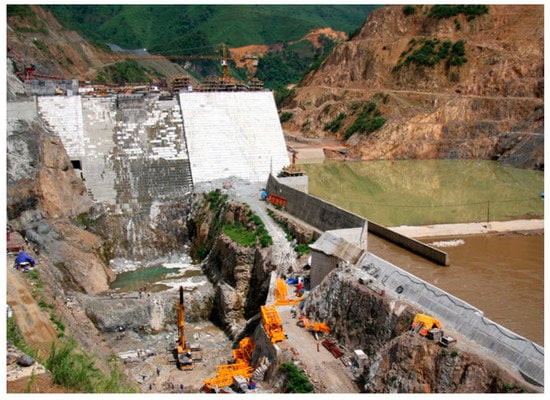
Figure 1.
Ban Chat hydroelectric plant in Vietnam [6].
Among these countries, Vietnam considers hydroelectric power to be the focus of its energy security and production strategy, instead of other sources such as nuclear power or thermal power [7]. However, there are many obstacles to developing hydroelectric projects in Vietnam, including environmental, social, economic, and political problems that need to be considered [7].
According to scientists, hydropower accounts for a large proportion of Vietnam’s electricity production structure and plays an important role in national energy security. In addition to generating electricity, hydropower plants are also responsible for cutting and fighting floods for downstream areas in the rainy season, and at the same time supplying water to downstream areas to meet people’s needs in the dry season. However, according to the Asian Development Bank’s (ADB) assessment of electricity planning, the risk to biodiversity is very serious because the hydroelectric dams are located near sensitive and high biodiversity areas. Thus, choosing an optimal location for hydroelectric plants is a multicriteria decision-making (MCDM) problem that requires the decision-maker to incorporate both quantitative and qualitative factors. MCDM refers to making the best choice from a finite set of decision alternatives, in terms of multiple, usually conflicting criteria [8].
The aim of this paper is to propose a hybrid MCDM model for hydroelectric location evaluation and selection in Vietnam. In the first stage of this research, all criteria affecting the hydroelectric plant location evaluation and selection process were defined by experts and a literature review. As many of these criteria were qualitative, it was necessary to solve this problem in a fuzzy environment. Thus, a fuzzy analytical network process (FANP) was used to determine the weight of all the criteria. In the final stage, a technique for order of preference by similarity to ideal solution (TOPSIS) was then applied, to rank all the potential plant locations.
The next part of this paper presents literature reviews to support the building of the MCDM model, methods of determining the parameters of the FANP model, and the TOPSIS model. Discussions and conclusions are presented at the end of the paper.
2. Literature Review
Many literatures have applied an MCDM approach in various fields and disciplines over the years. One of the most popular uses of MCDM is for solving location selection problems and many studies have employed MCDM in energy plant location decisions [9,10,11]. Farahani and Asgari [12] developed a model for selecting the optimal location of warehouses in a military logistics system. The authors used a TOPSIS model to assess the quality of potential locations, based on a given set of criteria, then used a multiple objective set covering model to obtain the optimal locations. Zak and Weglinski [13] introduced a two-stage procedure for a logistics center location selection problem, based on ELimination Et Choice Translating Reality III/V (ELECTRE III/V). In the first stage of the procedure, a macro-analysis of the regions was performed and multiple criteria affecting the selection process, including sustainability criteria, were obtained. Then, ELECTRE III/V was employed to obtain a complete ranking of the potential locations. Choudhury et al. [14] proposed a hybrid MCDM model, using the analytic hierarchy process (AHP) technique and a multivariant adaptive regression spline (MARS) through a polynomial neural network to find the optimal locations of surface water treatment plants.
Among many MDCM techniques, the TOPSIS and FANP models are frequently employed in solving location selection problems. Suder and Kahraman [15] employed a fuzzy TOPSIS model for selecting the optimal location of a university faculty office. Hanine et al. [16] proposed a hybrid model, using the FAHP (fuzzy analytical hierarchy process) and fuzzy TOPSIS models, to evaluate and select a location for a solid waste landfill site. In this research, the fuzzy AHP model was employed to calculate the weight of the selected criteria and model the linguistic ambiguity, whereas the fuzzy TOPSIS model was used to obtain the ranking of potential locations, with respect to the criteria. Hanine et al. [17] proposed a geophysical information system (GIS)-FAHP-TOPSIS method for location selection problems. In this paper, the authors incorporated a geophysical information system into a hybrid FAHP-TOPSIS multicriteria decision making model to create a method for selecting a landfill site of industrial wastes. Erkeyman et al. [18] developed a fuzzy TOPSIS model for selecting an optimal location for a logistics center in the northeast region of Turkey. In this research, the authors used geographical, physical, socio-economic, and cost factors to form the criteria. Then, a fuzzy TOPSIS model was used to obtain the rankings for three potential alternatives based on these criteria.
Location problems are one of many popular topics in energy production planning and MCDM models are often used to solve these problems. Wang et al. [19] proposed a hybrid MCDM model to assist decision-makers in the evaluation and selection of a solid waste energy plant in Vietnam. The proposed model was built by combining the FANP and TOPSIS techniques. Demirel and Vural [20] suggested FANP as a plausible technique to solve a multicriteria solar energy plant location selection problem. Samanlioglu and Ayag [21] introduced a hybrid FAHP-PROMETHEE II model to evaluate solar power plant potential locations in Turkey. In this paper, FAHP was employed to calculate the weights of criteria, while F-PROMETHEE II provided the rankings of potential solar power plant locations, with respect to the criteria. Jeong and Ramirez-Gomez [22] combined a geographic information system multicriteria decision analysis (GIS-MCDA) and fuzzy decision-making trial and evaluation laboratory (F-DEMATEL) technique to evaluate potential sites for biomass power plants. In this research, the authors used the F-DEMATEL to determine the weights of the criteria, which included environmental, socio-economic, and geophysical constraints. Then, the optimal locations with regards to these criteria are obtained through the use of a weighted linear combination technique.
3. Methodology
In order to build an effective location selection model, the implementation process was carried out in the main steps as shown in Figure 2:
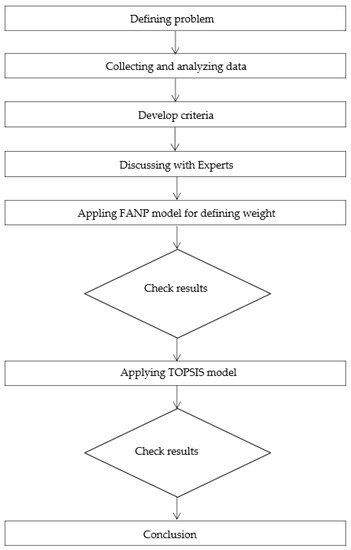
Figure 2.
Research graph.
3.1. Fuzzy Theory
The triangular fuzzy numbers (TFN) can be defined as and being the parameters that specify the smallest likely value, the promising value, and the largest possible value in TFN. TFN are shown in Figure 3 and can be described as:

Figure 3.
Triangular Fuzzy Number.
A fuzzy number is given as:
where represent the left side and the right side of a fuzzy number, respectively. The below shows basic calculations which involve two positive TFN, .
3.2. Fuzzy Analytic Network Process (FANP) Method
The fuzzy analytic network process (FANP) is commonly used as an alternative to the fuzzy analytical hierarchy process (FAHP) to determine priority weights from fuzzy comparison matrices, due to its simplicity in comparison with FAHP. For instance, Guneri et al. [23] employed FANP for a shipyard location selection process, while incorporating the extent analysis method introduced by Chang [24]. Assume that is an object set and is a set of goals. According to Chang [24], the process takes each object from the object set and performs an extent analysis of each goal () of the object. Therefore, m, the extent analysis values of each object, can be written as followed:
where are the TFN. Chang’s extent analysis process is described as follows:
Step 1: The fuzzy synthetic extent value of the object is calculated as:
The fuzzy addition operation of m extent analysis values of the object matrix () is calculated as:
The fuzzy additional operation of values () are performed as:
Then, the inversion of the vector in (5) is calculated as:
Step 2: The degree of possibility of ≥ is calculated as:
Which can be rewritten as follows:
where d is the ordinate of the highest intersection point D between and . To compare and , we need both the degree of possibility of and
Step 3: The degree of the possibility that a convex fuzzy number is greater than convex fuzzy number, with , is calculated as:
Under the assumption of , for , the weight vector is calculated as:
where are elements.
Step 4: Finally, the normalized weight vectors are calculated as:
3.3. Technique for Order Preference by Similarity to Ideal Solution (TOPSIS)
The TOPSIS method was introduced by Hwang et al. [25]. A typical TOPSIS procedure can be described as follows [26,27]:
Step 1: Construct a normalized decision matrix:
where and are original and normalized scores of a decision matrix, respectively.
Step 2: The normalized weight matrix is determined as follows:
where is the weight for the j criterion.
Step 3: Determine the PIS matrix and NIS matrix:
Step 4: Identifying the gap between the performance values of each option with the positive ideal solution (PIS) matrix and negative ideal solution (NIS) matrix:
Distance to PIS.
Distance to NIS.
where is the distance to the PIS and is the distance to the NIS for the option.
Step 5: Determine the preference value () for each option:
values are used to benchmark and determine the ranking of the potential options.
4. Case Study
Due to the geographical location of Vietnam, located in a tropical climate, with hot and humid rain, the country has access to relatively rich hydroelectric resources. The topographic distribution stretching from the north to the south, with a coast more than 3400 km long and an elevation change from sea level to more than 3100 m, has created a tremendous source of potential energy, generated by the terrain variation [28].
Many evaluation studies have shown that Vietnam can exploit hydroelectric power sources at about 25,000–26,000 MW, equivalent to about 90–100 billion kWh of electricity. However, the potential of hydroelectricity can be exploited even more: from 30,000 MW to 38,000 MW and an exploitable power of 100–110 billion kWh [28].
In order to serve the needs of industrialization and modernization, this period is very important for exploiting the country’s hydroelectric energy. The largest hydropower projects built and completed during this period were Son La Hydroelectricity (2400 MW), Lai Chau Hydroelectricity (1200 MW), and Huoi Quang Hydroelectricity (560 MW) [28].
Recently, the process of inter-reservoir operation for hydropower steps was established and signed by the prime minister to issue decisions for all river basins with hydropower steps. By 2018, a total of 80 large and medium hydropower projects had come into operation, with a total installed capacity of 15.999 MW [28]. It can be said that, to date, many large hydro projects with capacities of over 100 MW have been generated. Vietnam’s rivers network is shown in Figure 4.
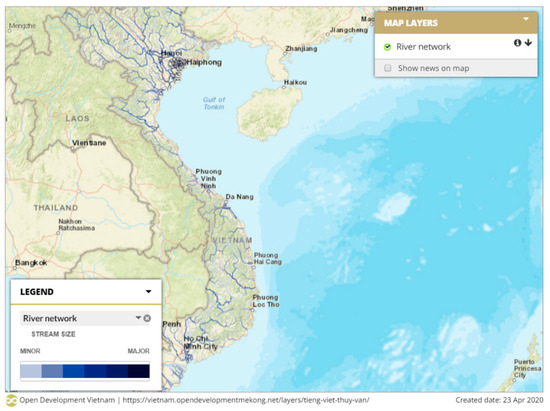
Figure 4.
Vietnam’s rivers network [29].
Therefore, the study of potential locations to invest in the construction of hydropower plants is essential in order to ensure a stable supply of energy for the socio-economic development of Vietnam. The river system of Vietnam is dense and distributed over many different territories. The potential for small hydroelectricity is concentrated mainly in the northern mountainous areas, the south-central areas, and the central highlands. Hydropower is still the most utilized renewable energy source, contributing about 40% of the total national electricity capacity. The potential of small hydroelectricity is huge, with more than 2200 rivers and streams with a length of over 10 km, 90% of which are small rivers and streams. These offer a favorable basis for developing small hydroelectricity [30].
To prove the research model is feasible, ten potential locations and fourteen criteria were considered. The names of the ten locations and their symbols in the MCDM model are shown in Table 1.

Table 1.
Name and symbol of ten location.
After conducting a literature review and consulting experts, fourteen criteria were selected to assess each potential location, including: protected fauna, fish population, flow regime, landscape quality, public opposition to project, water quality, vegetation, soil fragility and erosion, accumulation or synergy with other projects, project cost, rated power, distance of power house from grid line, distance of power house from village, and distance of power house from road. All the criteria are shown in Figure 5.
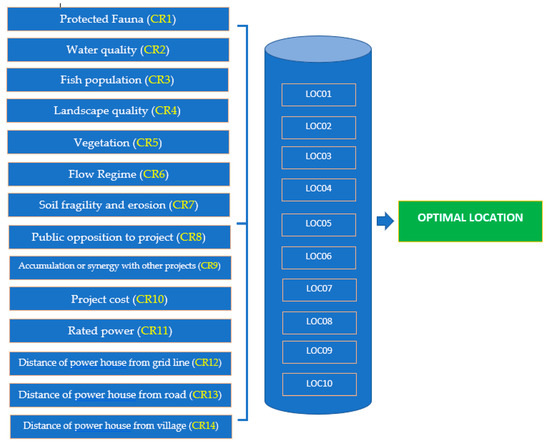
Figure 5.
Criteria affecting location selection.
The input data of the FANP model are determined by the opinions of experts. The fuzzy comparison matrix of goal from the FANP model is shown in Table 2.

Table 2.
Fuzzy comparison matrices for GOAL.
The fuzzy numbers were converted to real numbers by using the TFN. During the defuzzification, the authors obtained the coefficients α = 0.5 and β = 0.5. Here, α represents the uncertain environment conditions, and β represents the attitude of the evaluator is fair.
f0.5(LA1, A4) = (2 − 1) × 0.5 + 1 = 1.5
f0.5(UA1, A4) = 3 − (3 − 2) × 0.5 = 2.5
The remaining calculations for other criteria are as in the above calculation. The real number priority when comparing the main criteria pairs is shown in Table 3.

Table 3.
Real number priority.
For calculating the maximum individual value as following:
Q1 = (1 × 1 × 4 × 2 × 4)1/5 = 2
Q2 = (1 × 1 × 3 × 2 × 4)1/5 = 1.9
Q3 = (1/4 × 1/3 × 1 × 1/3 × 1/2)1/5 = 0.43
Q4 = (1/2 × 1/2 × 3 × 1 × 3)1/5 = 1.18
Q5 = (1/4 × 1/4 × 2 × 1/3 × 1)1/5 = 0.5
Based on number of main criteria, the authors found that n = 5; λmax and CI are calculated as following:
To calculate the CR value, we found that RI = 1.12, with n = 5.
Because CR = 0.0268 ≤ 0.1, there is no need to re-evaluate. The weights of criteria are shown in Table 4.

Table 4.
The weights of criteria.
To identify potential locations, the TOPSIS model was applied in the final phase of the study. Calculation results are shown in Table 5.

Table 5.
Results from TOPSIS Model.
The TOPSIS model is based on the concept that the chosen alternative should have the shortest geometric distance from the positive ideal solution (PIS) and the longest geometric distance from the negative ideal solution (NIS), which results in Nghe An (LOC05) being the most optimal location from the potential alternatives (Table 5 and Figure 6).
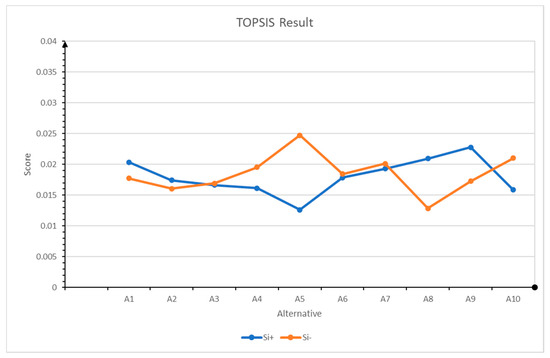
Figure 6.
PIS and NIS values.
5. Discussion
Hydropower has always been an important part of Vietnam’s national energy production structure and energy security. Hydropower dams are not only responsible for generating much-needed electricity—they also play an important part in controlling floods in rainy seasons and act as valued water reservoirs in dry seasons. However, while hydroelectric is a proven source of renewable energy, hydroelectric dams can cause serious environmental and social damage, such as the displacement of communities, declining number of fish, crippled food systems, and lower water quality [3].
Therefore, to ensure the goal of sustainable hydroelectric production is reached, it is necessary to improve the decision-making process by strengthening coordination among stakeholders, as well as improving quality in the participation of stakeholders. As most of the environmental and social problems of hydroelectric production are directly linked to a plant’s location, it is important that economic, social, and environmental criteria are considered in the hydroelectric dam location selection process. Thus, this decision-making process can be considered as a multi-criteria decision process, in which the decision-maker must consider both qualitative and quantitative factors. In the proposed model, there are fourteen economic, social, and environmental criteria, including: fauna protection, fish population, flow regime, landscape quality, public opposition to project, water quality, vegetation, soil fragility and erosion, accumulation or synergy with other projects, project cost, rated power, distance of power house from grid line, distance of the powerhouse from village, and distance of the powerhouse from road. In the case study, input data were applied to the proposed model, which resulted in Nghe An (LOC05) being the most optimal location from the potential alternatives (Table 5).
The proposed MCDM model will assist researchers and decision-makers in identifying the optimal locations for building hydroelectric plants, while incorporating important economic, social, and environmental criteria. This research can also be used to support similar location selection processes in other countries and industries where sustainability is an important factor.
6. Conclusions
In Vietnam, hydroelectric power accounts for a high proportion of the electricity production structure. Currently, although the electricity industry has developed to diversify power sources, hydropower still accounts for a significant proportion of these.
Large hydroelectric projects can cause negative environmental and social impacts. These projects require very large reservoirs and may lead to the loss of a large area of land, most of which is agricultural. Thousands of households may need to be relocated and resettled, a cultural area within the burial area of the lake may be disturbed, and greenhouse gas emissions (mainly methane) generated by flooded organisms in the lake may be affected. To sustainably exploit and develop hydroelectricity, everything—including planning, investment projects, technical designs, construction work, and operation management—absolutely must strictly comply with specific procedures. In addition, it is necessary to ensure the quality of the construction, as well as the response scenario for dams and natural disaster mitigation for the community. Thus, hydroelectric plant location selection is an MCDM problem that decision-makers must evaluate in terms of both qualitative and quantitative factors. This is the reason why the author proposes a fuzzy MCDM model for hydroelectric plant location selection in this work. For building this proposed model, the author considered fourteen criteria that related to the decision-making process.
The research implemented fuzzy theory and the ANP and TOPSIS models for selecting the most suitable location. The implementation, using a case study, shows that the proposed model is feasible. The combined model can also be studied in conjunction with other models to diversify options.
Author Contributions
Conceptualization, C.-N.W., V.T.N. (Van Thanh Nguyen) and K.Y.C.; Data curation, F.C., C.-N.W. and V.T.N. (Viet Tinh Nguyen); Formal analysis, F.C. and V.T.N. (Van Thanh Nguyen); Funding acquisition, F.C., C.-N.W., V.T.N. (Viet Tinh Nguyen) and V.T.N. (Van Thanh Nguyen); Investigation, F.C., V.T.N. (Viet Tinh Nguyen) and K.Y.C.; Methodology, V.T.N. (Van Thanh Nguyen) and K.Y.C.; Project administration, F.C., V.T.N. (Viet Tinh Nguyen) and V.T.N. (Van Thanh Nguyen); Resources, V.T.N. (Viet Tinh Nguyen), V.T.N. (Van Thanh Nguyen) and K.Y.C.; Software, C.-N.W., V.T.N. (Viet Tinh Nguyen) and K.Y.C.; Writing—original draft, V.T.N. (Van Thanh Nguyen); Writing—review and editing, F.C. and C.-N.W. All authors have read and agreed to the published version of the manuscript.
Funding
This research received no external funding.
Conflicts of Interest
The authors declare no conflict of interest.
References
- International Energy Agency. Fossil Fuel Energy Consumption (% of Total). 2015. Available online: https://data.worldbank.org/indicator/eg.use.comm.fo.zs?end=2015&start=1960&view=chart (accessed on 12 February 2020).
- International Energy Agency. Electricity production from hydroelectric sources (% of total) 2019. Available online: https://data.worldbank.org/indicator/EG.ELC.HYRO.ZS (accessed on 12 February 2020).
- Moran, E.; Lopez, M.C.; Moore, N.; Müller, N.; Hyndman, D.W. Sustainable hydropower in the 21st century. Proc. Natl. Acad. Sci. USA 2018, 115, 11891–11898. [Google Scholar] [CrossRef] [PubMed]
- United Nations General Assembly. Report of the World Commission on Environment and Development: Our Common Future. Transmitted to the General Assembly as an Annex to Document A/42/427–Development and International Co-Operation: Environment; Oxford University Press: Oxford, UK, 1987; (Retrieved on 15 February 2009). [Google Scholar]
- United Nations General Assembly. World Summit Outcome, Resolution A/60/1, adopted by the General Assembly on 15 September 2005; United Nations General Assembly: New York, NY, USA, 2005; (Retrieved on 17 February 2009). [Google Scholar]
- Petrovietnam Power Corporation. Khai thác tiềm năng thủy điện: Cơ hội thúc đẩy phát triển kinh tế. Available online: https://www.pvpower.vn/khai-thac-tiem-nang-thuy-dien-co-hoi-thuc-day-phat-trien-kinh-te/ (accessed on 21 January 2020).
- Nguyen, V.D.S. Yếu tố kinh tế chính trị trong xây dựng đập thủy điện ở Việt Nam; The Stimson Center: Washington, DC, USA, 2010. [Google Scholar]
- Xu, L.; Yang, J.-B. Introduction to Multi-Criteria Decision Making; Trong Working Paper; Manchester School of Management: Manchester, UK, 2001. [Google Scholar]
- Zhou, P.; Ang, B.; Poh, K. Decision analysis in energy and environmental modeling: An update. Energy 2006, 31, 2604–2622. [Google Scholar] [CrossRef]
- Wang, C.-N.; Nguyen, V.T.; Thai, H.T.N.; Duong, D.H. Multi-Criteria Decision Making (MCDM) Approaches for Solar Power Plant Location Selection in Viet Nam. Energies 2018, 11, 1504. [Google Scholar] [CrossRef]
- Loken, E. Use of multicriteria decision analysis methods for energy planning problems. Renew. Sustain. Energy Rev. 2007, 11, 1584–1595. [Google Scholar] [CrossRef]
- Rouhi, F.; Ebrahimi, S.B.; Ketabian, H. Development of International facility location model applying the combination of MCDM and location covering techniques under uncertainty. J. Ind. Manag. 2016, 7, 743–766. [Google Scholar]
- Zak, J.; Węgliński, S. The Selection of the Logistics Center Location Based on MCDM/A Methodology. Transp. Res. Procedia 2014, 3, 555–564. [Google Scholar] [CrossRef]
- Choudhury, S.; Howladar, P.; Majumder, M.; Saha, A.K. Application of Novel MCDM for Location Selection of Surface Water Treatment Plant. IEEE Trans. Eng. Manag. 2019, 1–13. [Google Scholar] [CrossRef]
- Suder, A.; Kahraman, C. Minimizing Environmental Risks Using Fuzzy TOPSIS: Location Selection for the ITU Faculty of Management. Hum. Ecol. Risk Assess. Int. J. 2015, 21, 1326–1340. [Google Scholar] [CrossRef]
- Hanine, M.; Boutkhoum, O.; El Maknissi, A.; Tikniouine, A.; Agouti, T. Decision making under uncertainty using PEES–fuzzy AHP–fuzzy TOPSIS methodology for landfill location selection. Environ. Syst. Decis. 2016, 36, 351–367. [Google Scholar] [CrossRef]
- Hanine, M.; Boutkhoum, O.; Tikniouine, A.; Agouti, T. An application of OLAP/GIS-Fuzzy AHP-TOPSIS methodology for decision making: Location selection for landfill of industrial wastes as a case study. KSCE J. Civ. Eng. 2016, 21, 2074–2084. [Google Scholar] [CrossRef]
- Erkayman, B.; Gundogar, E.; Akkaya, G.; Ipek, M. A Fuzzy Topsis Approach for Logistics Center Location Selection. J. Bus. Case Stud. (JBCS) 2011, 7, 49–54. [Google Scholar] [CrossRef]
- Wang, C.-N.; Nguyen, V.T.; Duong, D.H.; Thai, H.T.N. A Hybrid Fuzzy Analysis Network Process (FANP) and the Technique for Order of Preference by Similarity to Ideal Solution (TOPSIS) Approaches for Solid Waste to Energy Plant Location Selection in Vietnam. Appl. Sci. 2018, 8, 1100. [Google Scholar] [CrossRef]
- Demirel, T.; Vural, Z. Multicriteria solar energy plant using fuzzy ANP. In Computational Intelligence; World Scientific Publishing Pte.: Singapore, 2010; pp. 465–470. [Google Scholar]
- Samanlioglu, F.; Ayağ, Z. A fuzzy AHP-PROMETHEE II approach for evaluation of solar power plant location alternatives in Turkey. J. Intell. Fuzzy Syst. 2017, 33, 859–871. [Google Scholar] [CrossRef]
- Jeong, J.S.; Ramírez-Gómez, Á. Optimizing the location of a biomass plant with a fuzzy-DEcision-MAking Trial and Evaluation Laboratory (F-DEMATEL) and multi-criteria spatial decision assessment for renewable energy management and long-term sustainability. J. Clean. Prod. 2018, 182, 509–520. [Google Scholar] [CrossRef]
- Guneri, A.F.; Cengiz, M.; Şeker, S. A fuzzy ANP approach to shipyard location selection. Expert Syst. Appl. 2009, 36, 7992–7999. [Google Scholar] [CrossRef]
- Chang, D.-Y. Applications of the extent analysis method on fuzzy AHP. Eur. J. Oper. Res. 1996, 95, 649–655. [Google Scholar] [CrossRef]
- Hwang, C.-L.; Yoon, K. Methods for Multiple Attribute Decision Making; Springer Science and Business Media LLC: Berlin/Heidelberg, Germany, 1981; Volume 186, pp. 58–191. [Google Scholar]
- Behzadian, M.; Otaghsara, S.K.; Yazdani, M.; Ignatius, J. A state-of the-art survey of TOPSIS applications. Expert Syst. Appl. 2012, 39, 13051–13069. [Google Scholar] [CrossRef]
- Kusumadewi, S.; Hartati, S.; Harjoko, A.; Wardoyo, R. Fuzzy Multi-Attribute Decision Making (Fuzzy MADM); Graha Ilmu: Yogyakarta, Indonesia, 2006; pp. 78–79. [Google Scholar]
- Nguyen, S. Khái quát về thủy điện Việt Nam. Vietnam Electricity. Available online: https://www.evn.com.vn/d6/news/Khai-quat-ve-thuy-dien-Viet-Nam-6-12-23805.aspx (accessed on 15 January 2020).
- OpenDevelopmentMekong. Vietnam River Network. Available online: https://vietnam.opendevelopmentmekong.net/layers/tieng-viet-thuy-van/ (accessed on 6 January 2020).
- Thai, V.H.; Hang, C.T.T. TIỀM NĂNG VÀ THÁCH THỨC PHÁT TRIỂN NĂNG LƯỢNG TÁI TẠO Ở VIỆT NAM [KỲ 1]. Available online: http://socongthuong.tuyenquang.gov.vn/tin-tuc-su-kien/nang-luong-moi-truong/tiem-nang-va-thach-thuc-phat-trien-nang-luong-tai-tao-o-viet-nam-ky-1!-110.html (accessed on 21 January 2020).
© 2020 by the authors. Licensee MDPI, Basel, Switzerland. This article is an open access article distributed under the terms and conditions of the Creative Commons Attribution (CC BY) license (http://creativecommons.org/licenses/by/4.0/).